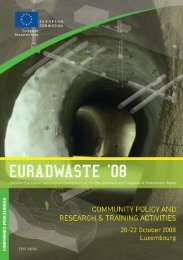EU industrial structure - EU Bookshop - Europa
EU industrial structure - EU Bookshop - Europa
EU industrial structure - EU Bookshop - Europa
Create successful ePaper yourself
Turn your PDF publications into a flip-book with our unique Google optimized e-Paper software.
<strong>EU</strong> <strong>industrial</strong> <strong>structure</strong> 2011 — Trends and Performance<br />
40<br />
box II.1: Indicator of a country’s sectoral specialisation<br />
The indicator of a country’s sectoral specialisation compares the share of a given sector in one country with the<br />
share of the same sector in the <strong>EU</strong> as a whole. A value of 1 for a sector indicates the same share for that sector in the<br />
country and in the <strong>EU</strong>. Values above (below) 1 indicate specialisation (lack of specialisation) of the country in that<br />
sector and, the higher the value of the indicator, the higher the country’s specialisation compared to the <strong>EU</strong> average.<br />
The index is calculated, for country ‘i’ and industry ‘j’, as follows:<br />
where VA is value added and <strong>EU</strong> refers to <strong>EU</strong>‑27.<br />
When interpreting the coefficient there are at least three caveats.<br />
1) Large countries mostly determine the sectoral profile of the <strong>EU</strong>, in which they are included. It is, therefore, less likely to<br />
find significant differences between large countries and the <strong>EU</strong> as a whole. For the same reason it is more likely to find<br />
a substantially different profile in small countries from that of the <strong>EU</strong>. This arithmetic property of the indicator affects the<br />
value of the index but not the specialisation profile of the country. However, the 2009 edition of <strong>EU</strong> <strong>industrial</strong> <strong>structure</strong><br />
(See Figure II.7 p. 61) showed that the results are not substantially affected by the method of calculation since changing<br />
the area of reference by excluding the country under analysis does not substantially alter those indicators. Nevertheless,<br />
other factors, as well as the way the indicator is calculated, explain the fact that small countries tend to show a sectoral<br />
profile different from the average. Large countries are in a naturally favourable position to initiate a larger number of<br />
activities successfully. Conversely, the obvious constraints that prevent small countries from developing a large range<br />
of economic activities lead these countries to specialise on the basis of, among other things, their own comparative<br />
advantages, their degree of development, the availability of specific resources, historical reasons, geographical and<br />
location advantages, and technical characteristics of the sectors (e.g. economies of scale).<br />
2) The level of sectoral aggregation also affects the results, as aggregation may mask the level of specialisation or lack<br />
of specialisation of a country in a given sector. This applies to the results presented in Section II.2, as the taxonomies<br />
for which the indicator is calculated are the result of aggregating sectors as defined in the NACE Rev. 1 nomenclature.<br />
3) Specialisation and size of the sector are not necessarily related. The fact that a country is specialised in a sector<br />
does not necessarily imply that the share of this sector in the economy of the country is large.<br />
degree of specialisation in a country<br />
While the indicator of sectoral specialisation provides a value for each sector in a given country, the degree of<br />
specialisation in a country is measured as the Euclidean distance between the country’s vector of specialisation and<br />
the vector corresponding to the non‑specialisation hypothetical case of non‑specialisation in which the coefficient<br />
of specialisation would take the value 1 for each sector. For country ‘i’ and ‘n’ sectors the coefficient that measures<br />
the degree of specialisation is calculated as follows.
















